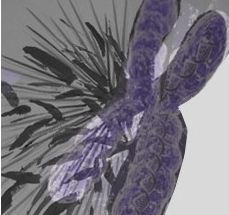‘Stealth’ properties of cancer-causing genetic mutations identified
Scientists have discovered that cancer-causing genetic mutations have better-disguised electronic signatures than other mutations - a trait which could help them fly under the radar of the body’s defence mechanisms.
Results of a new study by physicists at the University of Warwick and in Taiwan hint at the possibility that one day the electronic properties of DNA could play a role in early diagnosis and detection of mutation hotspots. Researchers drew on the power of supercomputers to model every possible mutation for 162 disease-related genes, a total of 5 billion calculations.
When they compared the models with medical databases of real-life mutations known to have caused cancer in individuals, they found that the real-life mutations had a “stealthier” electronic structure than the theoretical mutations which didn’t have a documented real-life counterpart.
These disease-causing mutations caused a smaller change in the electronic structure of the DNA molecule, which may make them less detectable to the cell’s damage repair process at work on a molecular level .
Professor Rudolf Roemer from the Department of Physics at the University of Warwick said: “We studied the scale of change in electronic charge transport for pathogenic mutations when compared to all possible mutations.
“We found that those mutations which had the smallest change in electronic properties correspond to those mutations which we know to have caused cancer in real life.
“You could compare these disease-causing mutations to planes that use stealth technology to go undetected by defence systems like radar.
“Similarly the real-life mutations that show up in the medical databases are likely to be the ones that didn’t have a sufficiently dramatic effect on the structure of the DNA when they first appeared, which is why they were not spotted and repaired early on by the body’s molecular defence mechanisms.
“It seems they are able to use stealth tactics which may allow them to go undetected by the body’s defence systems – making them all the more dangerous in their ability to then go on and cause a disease like cancer.”
Dr Stephen Wells of the Department of Physics at the University of Warwick added: “This is the first time scientists have identified a link between mutations and the electronic properties of disease-related genes.
“Although it is obviously very early days, these findings suggest that we could one day use these differences in electronic signatures as a red flag in terms of early detection of diseases like cancer.”
Original publication
Other news from the department science

Get the life science industry in your inbox
By submitting this form you agree that LUMITOS AG will send you the newsletter(s) selected above by email. Your data will not be passed on to third parties. Your data will be stored and processed in accordance with our data protection regulations. LUMITOS may contact you by email for the purpose of advertising or market and opinion surveys. You can revoke your consent at any time without giving reasons to LUMITOS AG, Ernst-Augustin-Str. 2, 12489 Berlin, Germany or by e-mail at revoke@lumitos.com with effect for the future. In addition, each email contains a link to unsubscribe from the corresponding newsletter.
More news from our other portals
Last viewed contents
List_of_beetle_species_recorded_in_Britain
Improvisation_in_music_therapy
Amorfix awarded "Life Science Company of the Year" for moving innovative products into commercialization
PregLem announces positivie phase III results from Esmya - PEARL I trial meets primary efficacy and safety endpoints
Genomes of identical twins reveal epigenetic changes that may play role in lupus
























































